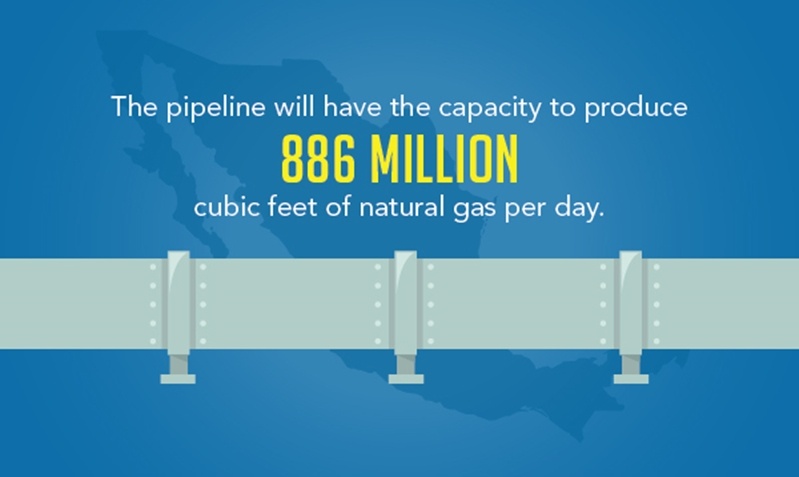For companies considering manufacturing in Mexico, reforms in the energy sector are seen as a major advantage.
TransCanada, a major North American energy company based in Calgary, Alberta, has been chosen to build, own and operate the Tuxpan-Tula Pipeline in Mexico, Canadian Manufacturing reported. The infrastructure for the pipeline is currently supported by a 25-year natural gas transportation service contract with the Comision Federal de Electricidad, Mexico's state-owned power company. TransCanada plans to invest roughly $500 million in the pipeline, which it anticipated will be fully functional in the final quarter of 2017.
"The Tuxpan-Tula Pipeline demonstrates our continued commitment to developing Mexico's energy infrastructure to meet the need for increased natural gas supply," Russ Girling, TransCanada's president and CEO, said.
The pipeline will have the capacity to produce 886 million cubic feet of natural gas per day.
TransCanada's massive investment in the country's energy infrastructure is just one among many indicators that Mexico is becoming a more attractive location for business and that companies there will soon have access to greater levels of infrastructure to make operations easier and more efficient. As more natural gas becomes available and prices go down, the appeal of manufacturing in Mexico will only become greater.
"As oil prices decline, the appeal of manufacturing in Mexico will only become greater."
Background on Mexico's energy sector
To understand why energy companies are jumping on the opportunity to invest in Mexico, it is first important to comprehend the history of CFE and Pemex, the former state-owned monopoly that controlled the country's energy sector. However, in December of 2013, the Mexican government reformed its constitution and restructured Pemex, requiring the company operate under the same standards as a privately owned business. Additionally, one of the the key changes that resulted from the reform was the opening of Mexico's doors to foreign and private investment in the energy sector.
Today, Mexico's energy sector is still undergoing reforms to make it more profitable. For example, Natural Gas Intelligence wrote that according to Arturo Palacios, a Mexico City-based consultant, losses are no longer covered by the government. Instead, starting in 2016, Pemex will have its own separate budget and must operate within those parameters. Palacios listed four key points that illustrate the new flexibility the company has as a result of owning its own profitability:
- Pemex can now acquire or own interests in other companies.
- The company can enter private-sector alliances and partnerships.
- Pemex can now issue financial guarantees and credit instruments.
- The company may enter into contracts under commercial laws.
Mexico's energy sector continues to evolve, and as a result, the country is experiencing rapid growth.
Pipelines indicate progress
Among other things such as increased economic activity and the country's major manufacturing boom, investment in pipelines throughout Mexico is a major indicator of progress there. For example, Reuters reported in March that asset manager BlackRock Inc and U.S. private equity firm First Reserve invested $900 million in the second phase of Mexico's Los Ramones pipeline project, which was the first major deal with a foreign investor since the energy reforms in 2013.
Further, CFE announced plans in June to unveil a new round of 24 energy infrastructure projects totaling $10 billion, Oil Price reported. According to the publication, the Mexican government had plans to increase the country's pipeline infrastructure by 75 percent by 2018.
This strategy, which aims to lower gas prices in Mexico and capitalize on the country's proximity to the U.S., is already seeing great success. As Mexico's energy market opened up, U.S. pipeline and gas companies developed a keen interested in Mexico's energy market. Forbes discussed a handful of projects that are illustrative of this fact. Some worth noting include:
- Kinder Morgan's Sierrita Pipeline: This pipeline became operational in 2014, bringing 1.9 billion cubic feet into Mexico daily. The line connects to others located near Tucson to Sasabe, Arizona, and connects to Mexican pipelines located at the border.
- Morgan Border Pipeline: This system is owned by KM Tehas and extends from a point of interconnection with the pipeline facilities of Pemex Gas Y Petroquimica Basica at the International Border between the U.S. and Mexico in Hidalgo County, Texas. The system connects with other intrastate facilities owned by KM Tejas. The system is capable of producing 300 million cubic feet of natural gas per day.
- Mier-Monterrey Pipeline: This pipeline is also owned by KM Tejas, and stretches from the International Border to Monterrey, Mexico. It can transport up to 375 million cubic feet of natural gas per day.
In addition to those three, Forbes listed five pipelines that have been proposed or are currently underway: Nueva Era, South Texa-Tuxpan, Houston Pipe Line, Trans Pecos, Comanche Trail and Roadrunner. The combined capacity of these nine pipelines is 6.5 billion cubic tons of natural gas per day, totaling capital budgets greater than $7 billion. With such a massive dollar amount driven by pipeline investments alone, there is no questioning how energy reforms in Mexico have served the its economy.
 Gas pipelines are a major part of Mexico's economic success.
Gas pipelines are a major part of Mexico's economic success.
The offshoring advantages
Where the energy companies stand to profit, manufacturers in Mexico are also in a position to benefit. For one, increased investment and development on pipelines means more natural gas will be available and the price of oil will fall. According to Globe and Capital, estimates from the U.S. Energy Information Administration reveals energy reform in Mexico could result in a 75 percent increase in the country's long-term oil production.
Additionally, lower oil prices mean electricity will become cheaper and more accessible. In fact, David Goldwyn of energy advisory firm Goldwyn Global Strategies told CNBC Mexico was able to reduce electricity costs for industrial customers by 10 percent in one year following the opening of the country's energy market in 2013.
Finally, energy investment in Mexico - as indicated by the rapid growth of pipelines there - means more companies will be able to operate more efficiently in the country, and supply chains will be improved for manufacturers. As Mexico becomes a more affordable, positive business environment, both suppliers and OEM manufacturers will move within its borders, giving companies easier access to the parts they need to manufacture final products.
Mexico's pipelines are a direct result of the country's energy form and the positive effects foreign investment has had on the country. As Pemex continues to evolve and operate more efficiently, the offshoring advantages of manufacturing in Mexico will become only more apparent.
Subscribe
Sign up and stay informed with tips, updates, and best practices for manufacturing in Mexico.





